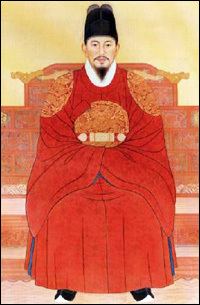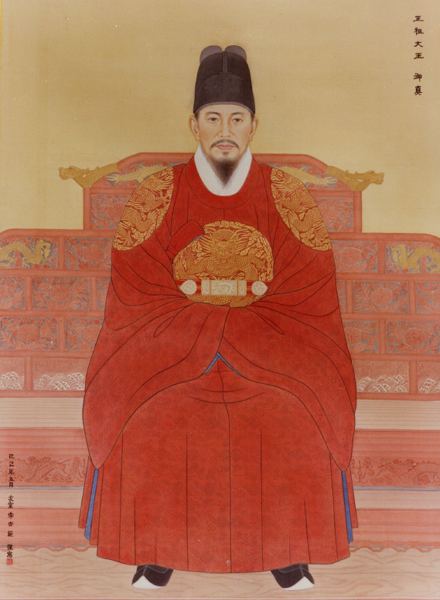Predecessor Yeongjo of Joseon Role Ruler Name Jeongjo Joseon | Children Sunjo of Joseon | |
 | ||
Reign 27 April 1776 – 18 August 1800 Born 28 October 1752Changgyeong Palace, Kingdom of Joseon ( 1752-10-28 ) Spouse Queen Hyoui,Royal Noble Consort Won, concubineRoyal Noble Consort Hwa, concubineRoyal Noble Consort Ui, concubineRoyal Noble Consort Su, concubine Issue Crown Prince MunhyoSunjo of Joseon Parents Lady Hyegyeong, Crown Prince Sado Grandparents Yeongjo of Joseon, Lady Yi Similar People | ||
Jeongjo of Joseon (28 October 1752 – 18 August 1800) was the 22nd ruler of the Joseon Dynasty of Korea (r. 1776-1800). He made various attempts to reform and improve the nation of Korea. He was preceded by his grandfather King Yeongjo (r. 1724–1776) and succeeded by his son King Sunjo (r. 1800–1834).
Contents

Some say Jeongjo is one of the most successful and visionary rulers of the Joseon Dynasty. But it is also pointed out that he was overestimated.
Early life
Born as Yi San, he was the son of Crown Prince Sado (who was put to death by his own father, King Yeongjo) and Lady Hyegyeong (who wrote an autobiography, The Memoirs of Lady Hyegyeong detailing her life as the ill-fated Crown Princess of Korea). Lady Hyegyeong's collection of memoirs serves as a significant source of historical information on the political happenings during the reigns of King Yeongjo (her father-in-law), King Jeongjo (her son), and King Sunjo (her grandson).
When he was the Crown Prince, King Jeongjo met Hong Guk-yeong (홍국영, 洪國榮), a controversial politician who first strongly supported Jeongjo's accession and toiled to improve the king's power, but ended up being expelled because of his desire for power.
Jeongjo spent much of his reign trying to clear his father's name. He also moved the court to the city of Suwon to be closer to his father's grave. He built Hwaseong Fortress to guard the tomb. It is now a UNESCO World Heritage Site.
Accession
The era before his rule was in disorder as his father was killed by royal decree of his own father, King Jeongjo's grandfather. King Yeongjo's ultimate decision to execute Crown Prince Sado was greatly influenced by other politicians who were against the Crown Prince. After King Yeongjo's death and on the day that Jeongjo became the King of Joseon, he sat on his throne in the throne room and looked at everyone and said, "I am the son of the late Crown Prince Sado..." This was a bold statement that sent shivers down the spines of all the politicians who were complicit in his father's death.
During his accession, he also issued a royal decree that his mother, Lady Hyegyeong, be a Dowager Queen since his father, her husband, was supposed to be the King before him. Thus, she became the Queen Dowager, the widow of Crown Prince Sado. From then on, King Jeongjo experienced many turbulent periods, but overcame them with the aid of Hong Guk-yeong.
Renaissance
King Jeongjo led the new renaissance of the Joseon Dynasty, but was initially stopped by continuing the policy of Yeongjo's Tangpyeong rule. He tried to control the politics of the whole nation to advance and further national progress.
He made various reforms throughout his reign, notably establishing Kyujanggak (규장각), a royal library. The primary purpose of Kyujanggak was to improve the cultural and political stance of Joseon and to recruit gifted officers to help run the nation. Jeongjo also spearheaded bold new social initiatives, including opening government positions to those who were previously barred because of their social status.
Jeongjo had the support of the many Silhak scholars who supported Jeongjo's regal power, including Scholars Jeong Yak-yong, Pak Ji-won, Pak Je-ga and Yu Deuk-gong. His reign also saw the further growth and development of Joseon's popular culture.
Death
King Jeongjo was known as an innovative person despite his high political status in Joseon. In 1800, he died suddenly under mysterious circumstances at the age of 48, without seeing his lifelong wishes that were later realized by his son, Sunjo. There are many books regarding the mysterious death of Jeongjo, and speculation as to the cause of his death continues even today.
He is buried with his wife, Queen Hyoui, at the royal tomb of Geolleung (건릉, 健陵) in the city of Hwaseong.
Family
- Queen Hyoui of the Cheongpung Kim clan (5 January 1754 – 10 April 1821) (효의왕후 김씨)
- Royal Noble Consort Ui of the Changnyeong Seong clan (6 August 1753 – 4 November 1786) (의빈 성씨)
- Yi Sun, Crown Prince Munhyo (13 October 1782 – 6 June 1786) (이순 문효세자)
- Unnamed Princess (1784)
- Unborn child (1786)
- Royal Noble Consort Su of the Bannam Park clan (8 May 1770 – 26 December 1822) (수빈 박씨)
- Crown Prince Yi Gong (29 July 1790 – 13 December 1834) (이공 왕세자)
- Princess Sukseon (1 March 1793 – 7 June 1836) (숙선옹주)
- Royal Noble Consort Won of the Pungsan Hong clan (27 May 1766 – 7 May 1779) (원빈 홍씨)
- Royal Noble Consort Hwa of the Namwon Yun clan (1765 – 1824) (화빈 윤씨)
